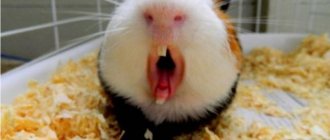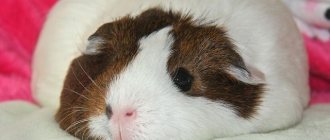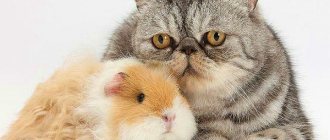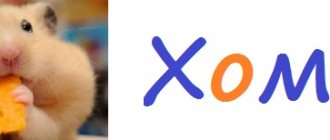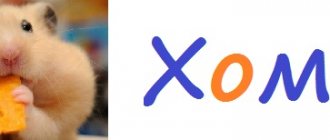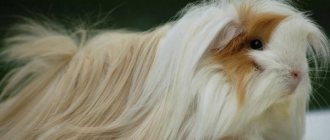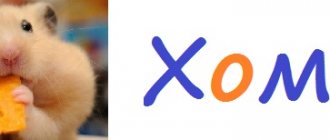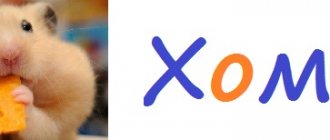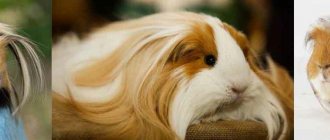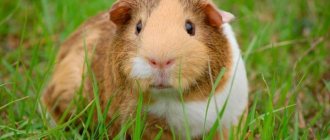Coronet is a guinea pig obtained through careful selection and crossing. Several decades ago, an Englishwoman named Claire White, who breeds guinea pigs, decided to breed a new breed of these animals. As parents, she chose representatives of short-haired and long-haired breeds - English Crested and Sheltie, respectively. As you know, the “highlight” of Crested rodents is the hair on the head, growing in a rosette. As a result of the selection, a breed of long-haired pigs with a woolen crown on their heads was born, which received the characteristic name Coronet.
Description of the Coronet guinea pig
We are confident that a breed such as the Coronet will take pride of place among guinea pig lovers, because it is impossible not to be amazed at the sight of a pig of this breed.
The Coronet Guinea Pig is a long-haired guinea pig breed similar to the Sheltie breed, with a long, smooth coat that grows from the head back across the body. However, the main difference between Shelties and Coronets is that the latter have a crown-shaped rosette comb on the top of their heads, hence the breed's name.
The Coronet is one of the newest breeds of guinea pigs that has not yet become widespread, so you can now buy a Coronet pig only from breeders who breed this breed.
Longhair
Shaggy breeds have thick, long fur and are in great demand among lovers of fluffy decorative rodents. They were bred artificially and subjected to strict selective selection.
Breeds whose standard officially includes a pure white color include the Peruvian (Angora) and Abyssinian guinea pig, Merino, Sheltie, Coronet, Texel and alpaca.
Abyssinian
This is the most interesting and most recognizable breed. The Abyssinian guinea pig has one very striking distinctive feature that immediately sets it apart from other varieties.
The Abyssinian coat must have so-called rosettes. They are a kind of funnels and appeared as a result of a genetic mutation.
Each Abyssinian guinea pig has about 6-10 rosettes on its body. They are located throughout the body and are absent only on the head and belly of the animal. Occasionally, the Abyssinian guinea pig has so-called “double rosettes.”
Their maximum number can reach 30 pieces. The animal's long fur can be painted in almost any color, including white.
Alpaca
Alpaca guinea pigs are covered with long, curly hair, the structure of which is more reminiscent of sheep's fleece. It grows from the tail to the head and forms a pair of rosettes on the rump and one on the crown. Representatives of the alpaca breed have coarser hair on their faces.
The color of the animals can be almost any color, including white. Occasionally among alpaca guinea pigs there are two- or three-colored individuals.
Coronet
The Coronet guinea pig has very long hair that flows down the sides and does not cover the face. There is a single rosette on the animal's head.
The coronet guinea pig comes in a variety of colors. It can be either monochromatic or combined. It is noteworthy that the white coronet is not very popular among breeders. It is believed that outwardly it loses to its brighter brothers.
Texel
The Texel cavy is covered with curly hair, the length of which reaches 15 cm. It grows from the head to the back of the body and cascades down the back.
The Texel guinea pig can have almost any color. Among the representatives of the breed there are even white individuals.
Merino
The breed was created by crossing a Coronet and a Texel. It has a crown-shaped rosette on its head and long, wavy fur that is white, gray or other colors.
Sheltie
The Sheltie guinea pig has long hair that does not flow along the sides, but simply falls back. More dense hair grows on the animal’s head, creating a kind of mane.
The Sheltie can have almost any color. But the white representative of this breed attracts less attention than his colored counterparts.
Peruvian
The Peruvian pig is also called the Angora pig. She has an aristocratic appearance and beautiful fur. There are rosettes on the nose and sacrum. The animal's muzzle is covered with long bangs. The Peruvian pig, or angora, weighs up to 1.5 kg and lives up to 6 years. It is painted in almost any color, including white.
Most often, Peruvian guinea pigs have silver-gray fur. Solid white color is extremely rare in the breed. Therefore, such caves are highly valued by breeders.
The long, soft coat of Angora Cavies grows straight forward. She needs careful care. Peruvian guinea pigs need to be brushed and trimmed regularly. And white animals can occasionally be washed with special shampoos for rodents.
From the history of coronet guinea pigs
As mentioned above, the breed is new; it appeared relatively recently, thanks to carefully thought-out selection. In the mid-1970s, a breeder from England, Claire White, crossed two breeds of guinea pigs: Sheltie and Crested. As a result, two genes merged, the same as in Texels, only here the Coronet had the St gene (rosette on the head) and L, the gene responsible for long hair. The St gene is dominant while the L gene is recessive, and it took many, many generations of pigs to finally get where we are today. In any case, Coronet guinea pigs are the product of hard work, not a happy accident. And the work to improve the breed, which has continued for many years, has brought significant success.
The Coronet breed received official recognition in the United States in 1998, when ARBA included it in the list of breeds recognized by the association.
History of the breed
This breed is a real “royal person” among its relatives, and its stunning appearance and always fashionable “hairstyle” have made it very popular among rodent lovers. The history of the appearance of this breed is also very interesting. The Sheltie is the result of artificial selection and the breed dates back to 1938 by crossing Peruvian and American varieties. But the breed finally took shape and received universal recognition only in 1978. After numerous experiments, guinea pigs with magnificent silky strands on the back of various colors were obtained. This breed is certainly one of the most popular at shows.
Features of Coronet guinea pigs
So, the main distinguishing features of the Coronet are its long, smooth coat, like that of a Sheltie, and a comb, like that of a Crested. Coronet combs can be of any color. And the color of these pigs can also be of any shade and color: the standards allow any variations, both single-color and with a combination of several colors.
In addition, there may be satin coronet, with a more shiny, smooth and dense coat that shimmers in the light and looks like satin. The average lifespan of coronet ranges from 6 years to 8 years.
The Coronet breed, due to its long hair, is not ideal for beginner pig breeders or for children. The main advantage of the Coronet - its coat - will require additional daily care.
Other interesting varieties
The Curly pig's fur is gathered into tousled curls. They look long, but they are not. You won't be able to comb them perfectly. And it's not necessary. The animal looks funny and is pleasant to the touch. The pig is reminiscent of Teddy and Rex in terms of the stiffness and unruliness of its fur. The body length of the Curly reaches 25 cm. The weight of an adult is 1 kg.
The Lunkaria pig is genetically closely related to the Curly breed. Only her fur is longer and more tousled. Another unique breed among guinea pigs is the Kui breed. An adult specimen weighs up to 4 kg. These rodents are bred for fur, meat and fertilizer production.
There are many guinea pigs in nature. Geneticists continue to develop new breeds for exhibitions. In the Russian Federation, some nurseries are engaged in breeding rare species. In ordinary pet stores, only popular short-haired varieties are found. They are easier to keep at home.
Care and maintenance of coronet
Caring for Coronets is not much different from caring for other breeds of pigs. Only because of their long hair do they require daily inspection. This fact must be taken into account before you decide to get such a pig or want to start breeding. The most important requirement is more time. If proper care is not given, their hair will become tangled and this will be unpleasant for both the pig and the owner.
Curls are most often used to care for the coat of show-class pigs.
Here is what the famous Coronet breeder Dorothy Wilson, Cherished Cavies nursery, writes about care:
“I spend a lot of time caring for my pigs every day.
They live in small groups of two to four in very large cages that I keep in the basement. In each cage the pigs have a lot of toys so they don’t get bored and a lot of houses so they have a place to sleep. Every night I spend about an hour getting everyone water and fresh vegetables. When I'm downstairs (in the basement), I pick out a few pigs and take them to my bedroom to get them ready for showing. Cleaning the cages takes 8 hours a week, after all the cages are cleaned I begin to examine each pig. I trim the claws and sort out the tangles in the fur. Those pigs that are in the bedroom are very carefully examined every two days, the wool is groomed and kept in curlers.
And when the pig's show career ends, the train is cut for the pig's comfort.
It takes a huge amount of time, but I enjoy the time I spend with the pigs."
Coronet, like other guinea pigs, is only suitable for indoor keeping; such pets cannot live outside. They can (and should!) be let out for a walk during the warm season. And in winter, a walk around the room will be enough. Guinea pigs need a lot of exercise and love to play and explore the world around them.
Keeping smooth-haired guinea pigs at home
Smooth-haired guinea pigs do not require special conditions for comfort. They need all the same accessories for life as most pigs. Of course, like any small pet, a pig needs a cage.
The cell arrangement is standard. The pig needs a place to rest, a “dining room”, a “restroom” and a play area.
Cell
For smooth-haired pets, choose a cage with a plastic tray. The minimum dimensions for one pet are 80*90 cm, height 35 cm.
The cage contains:
- A reserve for hay, where the animal can feed itself with dry grass and also build a nest for itself;
- feeder;
- sippy cup;
- tray;
- house;
- toys;
- litter
The cage must be installed on a straight surface without tilting
It is important to avoid direct sunlight and drafts when choosing a location for the cage. Before putting hay in the cage, you need to knead it well with your hands.
Experienced breeders use soft dried timothy grass.
Caring for the animal and cleaning the cage
To keep your animal clean, you will need to carry out the following procedures:
- Combing out fur;
- trimming claws;
- water procedures;
- ear treatment;
- home cleaning.
The fur should be brushed daily. This procedure will remove dead hair and stimulate the growth of new fur. This activity will bring your pet a lot of pleasure, because the brush massages the skin. It is better to choose a brush with natural soft bristles.
A rodent needs a manicure just like its owner. Uncut legs grow, curl and become the cause of musculoskeletal problems, as well as bacterial diseases. To keep the animal clean and healthy, it is necessary to trim its claws once every 2-4 weeks with a special nail clipper or electric file. These tools are sold at pet stores. When trimming, you need to be extremely careful so as not to touch the nerve and vessel located at the base of the claw. To perform the procedure correctly and safely, it is recommended to consult a veterinarian or study the relevant materials on caring for pigs.
Water procedures are not so necessary. The pig cleans its own fur. But there are times when a pet is so dirty that a bath is indispensable. For swimming you will need:
- bath with anti-slip mat;
- water with a temperature of 24 degrees;
- special shampoo;
- terry towel.
It is important to ensure that water does not get into your pet's ears. Immediately after bathing, the pig should be wrapped in a towel, as these animals are susceptible to colds.
Minor stains and daily wet care can be carried out using special wet wipes.
Cleaning the ears is a very important step in caring for your pet. You need to clean your ears regularly with a stick soaked in chlorhexidine. If there are dried crusts in the ears, then the Bars solution is instilled into the ears. It is sold in pet pharmacies. And if your pet squeals when trying to clean its ears, then you need to take it to the veterinarian. Perhaps an ear mite has settled in your pet's ear canals.
Cleaning the cage consists of daily washing the feeder and disposing of leftover food. The litter needs to be changed twice a week. General cleaning, which includes treating all surfaces of the cage and objects, is carried out once a month.
Feeding and water
Guinea pigs are fed 2 times a day. In the morning they offer fresh vegetables, fruits and herbs, and in the afternoon dry food (cereals, seeds, bran).
Your pet's diet must include:
- Grains and seeds;
- fresh vegetables (carrots, cucumbers, beets, boiled potatoes);
- fruits (apple, pear, berries);
- fresh grass and hay (lettuce, dandelion);
- bran.
Your pet must have clean and fresh water in his cage. It is recommended to add a solution of vitamin C to it.
To grind down your pet's teeth, you need a mineral stone.
Pigs should not be fed:
- Dairy and fermented milk products;
- meat, fish, eggs;
- cooked dishes (fried, spicy, smoked);
- spicy vegetables (radish, pepper, onion);
- cabbage
Smooth-haired guinea pigs are distinguished by their unpretentiousness, ease of care and maintenance, as well as their friendliness. This makes them a favorite among breeders. And the bizarre types of pets’ fur cannot but delight their owners.
Coronet cage
Every guinea pig needs a home. Most often this is a cell. The main requirement for a cage is space. Guinea pigs are quite active and mobile animals; they vitally need to move a lot. The minimum allowable area of a cage for a guinea pig is 0.6 square meters, which corresponds to a size of 100x60 cm. All those cages that are smaller in size are not suitable for guinea pigs. Of course, you can put your pet in a smaller cage, but in this case you need to be prepared for possible future problems with the health and character of the guinea pig.
Read about what a cage should be like in the article “Cage for a Guinea Pig”
Keeping long-haired guinea pigs at home
Let's look at the requirements for the conditions of keeping and caring for long-haired guinea pigs, and also tell you what you should not feed your pet.
The choice of cell should be approached responsibly:
- cage dimensions - 60x40x60 cm;
- materials - metal and plastic;
- necessary accessories - a drinking bowl, a manger for hay, a feeder for bulk feed, a mineral stone, twigs of an apple or birch tree, a small house, a tray with sawdust.
The cage must be equipped with the following accessories:
- The drinking bowl is purchased at a pet store; its volume does not matter, since the products are standardized and therefore suitable for almost any guinea pig.
- The manger should be made of plastic to make it easier to clean. Choose a ceramic feeder for factory mixtures so that your pet turns it over less often. Wooden products are not suitable, as they not only absorb moisture and odors, but are also damaged by rodents.
- Mineral stone is used to grind down teeth that grow throughout life. If the guinea pig does not have such a stone in its cage, then it will begin to sharpen its incisors on the first objects it comes across.
- Twigs are needed so that the rodent does not have the desire to sharpen your furniture or wooden accessories. The presence of stone does not eliminate the need for branches.
- The house is used by the pet as a shelter, as well as an escape from too bright light. For this reason, it is better to buy a cage together with a house, or purchase it separately from the very beginning.
- A tray of sawdust is used by rodents as a toilet. This allows you to change the bedding in the cage every few days, and also eliminate the appearance of an unpleasant odor in the room.
- Small sawdust or large shavings are used as the main bedding. Since wood absorbs moisture and odors, after removing the chips there is no need to further rinse or disinfect the tray.
Cozy corner
Care and hygiene
The main emphasis in care is on the coat to avoid tangling. Three to four times a week, the pig is combed with a soft brush, after lightly sprinkling water on the hair to reduce tugging. Combing begins only after the tangles have been removed. It is recommended to trim pigs with very long and thick fur before summer.
It is also recommended to trim the hair around the nipples of lactating females. A guinea pig should be bathed if it is very dirty. Having completed the washing, it is dried with a terry towel and dried with a hairdryer, making sure that the hot air does not burn the animal.
What to feed the coronet?
Just like all guinea pigs, Coronets are herbivores. Their main food is vegetables, fruits, fresh grass or hay, special pellets and clean drinking water. In addition, experts recommend adding vitamin C to food or water, since guinea pigs, along with humans, are a rare species of mammals in whose body vitamin C is not synthesized, but comes only from the outside.
Read more about the intricacies of guinea pig nutrition in the “Nutrition” section of the same name.
Choosing and arranging a home
For a Peruvian guinea pig, you need to purchase a spacious cage, terrarium or enclosure.
All equipment must be durable and reliable so that food does not spill or water spills. In a spacious cage, you can equip a separate toilet, because pigs like to go to one place. This simplifies the cleaning that needs to be done daily.
It is best to place the cage in well-lit areas.
Keeping animals in a dark corner of the room has an adverse effect on the health and behavior of the rodent, so breeders are urged to place the cage near a window. However, in this case, drafts, which are destructive for Peruvians, should be carefully avoided.
It is very important that the place to sleep is comfortable. It is not recommended to buy houses, because pigs can hide there and become unsociable
It is better to choose a hammock or tunnel made of soft material.
Coronet coat care
The long coat of Coronet breeds requires more grooming than the coat of short-haired guinea pig breeds. If you do not take care of the appearance of the Coronet's fur, it may become matted or lose its shine.
In principle, there is nothing complicated or prohibitive in care. It is enough to comb and trim it regularly. To do this you will need a special comb or brush and sharp scissors.
When caring for coronets, special attention should be paid to the hair near the anus. Here it needs to be trimmed as short as possible, since excrement can contaminate it.
If your pet does not participate in exhibitions and shows, then the coat can be trimmed to a comfortable length. This will make life a lot easier for both yourself and your guinea pig.
For show-class animals, the best option would be a grooming procedure once or twice a month.
So regular brushing and combing is the key to keeping your Coronet's coat looking great, and if you don't have the time for that, it may be worth choosing a less finicky pet.
Curly wool - miracles of selection
Texel
One of the cutest guinea pig breeds is the curly Texel. Despite the structure of the coat, it is very soft and not difficult to comb. But the combing procedure must be carried out daily due to the constant tangling of curls. It is not recommended to keep curlies on sawdust - it easily gets stuck in their long fur. Wood pellets will work instead. The character is friendly, but loners are more common among them. Such representatives can only be identified in professional nurseries, so do not condemn the animal to loneliness without reason.
Merino
Merino got its name from the elite breed of Merino sheep and was developed as a result of crossing Texels and Coronets. From the latter they received a characteristic rosette, which looks a little more careless due to the curly hair. Caring for them is different in that they should not be combed unnecessarily, as this spoils the structure of their curls, like after curlers. Periodic haircuts are enough. From childhood you need to accustom the merino to an active lifestyle, otherwise he will grow up lazy.
Texel (left) and Merino (right) guinea pigs
Lunkaria
The Lunkaria breed is divided into Lunkaria Sheltie and Lunkaria Peruvian. The Peruvian subtype has a longer, coarse coat and two distinctive rosettes are also visible. Lunkaria Shelties are distinguished by beautiful curls and the absence of rosettes at all. The character of the Sheltie subtype is much more playful and active than that of the Peruvian.
Curley
The short-haired representative of curls is Curly. The history of their breeding is not as transparent as we would like. The first version is the result of crossing Teddy with Rex. The second is the origin of a pair of lunkaria and a short-haired pig. The main differences between Curly: short and curly wool, similar to sheep, a tummy full of curls, “sideburns” on the muzzle, and the presence of a rosette on the sacrum.
On the left - Curley, in the middle - Lunkaria Sheltie, on the right - Lunkaria Peruvian
Description
The rodent's physique is quite large, has a dense body shape and a massive skull. Coronets' eyeballs are convex and stand out on the muzzle. Guinea pigs of this breed have a thick coat of hair that flows down the body like a mane. On the back the coat is parted, forming a crown at the withers. The most purebred individuals have a clear parting with pronounced symmetry. Thanks to the massive skull, the crown on the top of the head rises without breaking into two sides. The coat color is varied, there are both combinations of two or three colors, as well as a uniform monotonous color. The pig's comb may differ in color from the rest of the body. There are smoother, shiny and matte coats.
The body weight of an adult varies between 800 g and 1 kg. Male guinea pigs can reach up to one and a half kilograms, and their body length is more than 30 cm. The life cycle of the coronet reaches up to 8 years, this makes them similar to the classic breed of guinea pigs. Given the unusual coat, the guinea pig needs additional care and cleaning from dirt.
Distribution of guinea pigs in Europe
During the years of the conquest of South America, the conquistadors gradually moved deeper into the continent and, naturally, encountered rodents weighing 1.0-1.5 kg in Indian villages and also ate them. Before setting off on the return voyage to Europe, pens were made on ships, and the herbivorous guinea pigs became a constant supply of fresh meat. True, some of the uneaten specimens ended up like unusual exotic pets in the homes of wealthy Europeans. Cute little animals quickly became fashionable among noble ladies and they began to be imported specifically for sale, and later bred in suitable conditions in the countryside. So they quickly spread throughout European countries, and then came to Russia.
Guinea pigs have become favorite decorative animals for children and adults around the world, and breeders have continued selection in other more aesthetic directions. If, as a result of painstaking work, a more curly or miniature guinea pig appeared, the price for it increased sharply, which is why today many selective ornamental breeds are sold all over the planet and the selection work continues.
Nowadays, guinea pig breeds are divided into groups, which include:
- short-haired, with a subspecies of smooth-haired;
- long-haired;
- wire-haired;
- without wool and with a small amount of wool.
A more detailed description of the guinea pig breeds in each group is further divided and each of them has its own leaders in popularity among amateurs and professional sellers.
Representatives of the short-haired group are the easiest to adopt at the initial stage of becoming interested in guinea pigs.
Below are just the most popular guinea pig breeds among pet lovers.
Where to buy a purebred pig and its cost
The price of a Coronet guinea pig is directly proportional to the quality of breeding; you should not purchase the animal from your own hands, but only from an experienced breeder. The most thoroughbred individuals cost from two thousand rubles, however, exhibition specimens reach 4–6 thousand. You should not buy an animal for a family where there are small children or the owners are rarely at home. A guinea pig needs attention and care, but you should not bother your pet too much, so as not to provoke the development of stress.
As with any pedigree animals, there are exhibition evaluation criteria; if you plan to participate in shows, it is worth remembering that the length of the coat must be long enough along the body and muzzle. The thickness of the coat can also be a reason for refusal to participate, as can the shape of the crown.
Behavior and character
When purchasing a new pet, future owners are concerned about possible behavioral difficulties, but this has little impact on this breed. Like their short-haired cousins, Coronet cats have a quiet nature coupled with curiosity and playfulness. They are calm and non-conflict, they tolerate the public and the company of people well. Befitting their appearance, the animals are quiet and regal, which allowed them to become exhibition specimens. Moreover, these rodents need attention and affection, cannot stand prolonged loneliness and get along well with their relatives.
Conditions of detention
It is not recommended to purchase this guinea pig if you have no previous experience in caring for animals; long hair is not only beautiful, but also needs to be combed out so that tangles do not form. It is the beautiful wool that creates individual care requirements.
- The coronet's cage should be spacious and comfortable, take into account the research qualities and activity of the pet, and do not deprive it of toys and space. The minimum cell parameters start with a volume of 100x60 centimeters. If you have previously owned smaller rodents, don't expect the Coronet to be comfortable in their home. In cramped conditions, the rodent will begin to experience stress and may become aggressive and irritable. It is worth placing hay at the bottom of the cage, and ensuring a comfortable temperature during the hot season.
- The diet of these guinea pigs differs little from their younger counterparts; the diet is based on vegetables and fruits, special food, and dry or fresh grass. Renew the water in the drinking bowl as often as possible. You can add special vitamins to it to support your pet’s immune system. The main one is vitamin C; animals do not get it from the outside or from their bodies. Mineral supplements and stones are also good for your health, but also for your pet's teeth. Like other guinea pigs, teeth continue to grow throughout their life cycle, so they need constant sharpening.
- Wool requires additional care; without proper control, tangles can develop, and the coating will lose its natural shine. Shiny fur is an indicator of your pet's health. You shouldn’t think that grooming is difficult, what’s more important is its regularity. Buy a comb and scissors to rid your pet of excess hair. Be aware of the fur on the back of the body; long hair can get caught in excrement particles, so it needs to be cut short.
How to find out the breed of a baby guinea pig
• Most of the listed breeds are born with a characteristic fluffy appearance and open eyes.
Therefore, the description of the breeds is suitable for small cubs. • Lunkaria cubs can be identified by their coarse, curly coat, which softens with age. • At the time of gaining independence, small long-haired piglets already have hair 2-3 centimeters long, which is longer than that of ordinary piglets. • Questions may arise when choosing a baby bald. If in front of you is a month-old cub and it is almost completely hairless, except for the nose and paws, then you have Skinny in front of you. Baldyki remain fluffy for up to a month, maximum two. Next, they shed their fur, starting from the head. There is a risk of getting caught by a Baldwin mixed breed with a woolly pig. Such representatives have such good health, but not a very aesthetic appearance - there may be areas of skin covered with sparse long hair. There is no need to worry if you have the opportunity to adopt a one-year-old animal, because the life expectancy of guinea pigs at home is about 8 years, and you can meet centenarians 10 years and older. Guinea pig, guinea pig breeds
Breeding
Many people get two individuals at once, for subsequent breeding and sale. Obviously, only two-breed animals should be crossed; color does not matter. Females reach puberty at the age of 6–8 months; for breeding, it is worth mating at the very first heat. Estrus lasts about 14 hours every two weeks. The duration of gestation is two months, the litter is born with open eyes and only needs the care of the mother. Adult females who have passed the threshold of two years should not be exposed to the risk of pregnancy. Males mature somewhat later, closer to 10–12 months. When selecting partners, be guided by exhibition requirements and previous breeders.
Reviews
Most owners speak positively about keeping their pets. These animals are able to please not only with their charming appearance, reminiscent of imperious royalty, but also with their quiet character. The only difficulty is acquiring purebred individuals; many breeders have a schedule for selling cubs months in advance. Most sellers immediately describe the nuances of care, focusing on the wool. Many are attracted not only by the chic curls of coronets, but also by the variety of colors. Tri-colored, spotted pigs have gained particular popularity. A common combination is white, red and black. Some owners even come up with hairstyles for their pets, but you shouldn’t get carried away with this idea.
